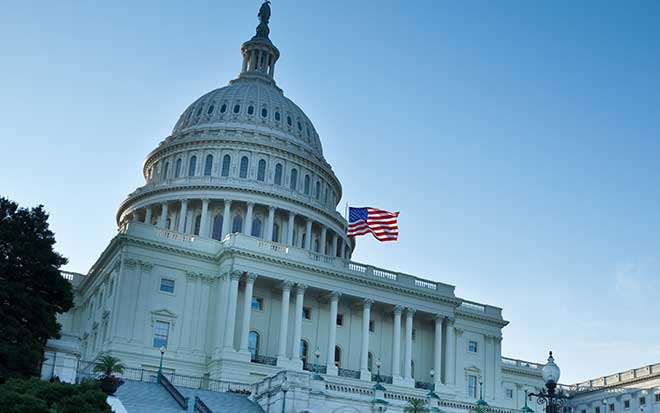June 28, 2024
Moore v. United States -Mandatory Repatriation Tax Found Constitutional
On June 20, the U.S. Supreme Court upheld the constitutionality of the mandatory repatriation tax (“MRT”), which taxes U.S. shareholders on the accumulated post-1986 deferred foreign income of certain foreign corporations that had not previously been subject to U.S. tax.[1] In Moore v. United States,[2] the Court affirmed the Ninth Circuit’s dismissal of a couple’s suit for refund of taxes paid on undistributed earnings from their interest in a controlled foreign corporation (“CFC”).
CFCs are treated as “pass-through” entities with respect to certain types of passive income, meaning that passive items of income of a CFC “pass through” to, i.e., is attributed to, U.S. shareholders who are then taxed on that income under Subpart F of the Internal Revenue Code (“IRC”).[3] Subpart F only applies to a portion of the CFC’s income, mainly passive income. Prior to the enactment of the 2017 Tax Cuts and Jobs Act (the “TCJA”), foreign corporations controlled by U.S. shareholders did not have an income inclusion of profits accumulated abroad in connection with trade or business activities until they were repatriated to the U.S. In the TCJA, Congress imposed the MRT, a one-time, backward-looking, pass-through tax on U.S. shareholders of CFCs to tax the trillions of dollars that had been accumulated by such CFCs over the years.[4]
In 2006, Charles and Kathleen Moore acquired a 13%-ownership share in KisanKraft, a CFC located in India that sells agricultural tools and equipment to farmers in India. KisanKraft generated income but did not distribute that income to its U.S. shareholders. Therefore, no income from KisanKraft was taxed in the U.S. The MRT imposed under the TCJA caused Charles and Kathleen to incur a tax of $14,729 on the Moore’s’ pro rata share of the undistributed earnings that had been accumulated by KisanKraft for the years that they were shareholders.[5] After payment of the tax, the taxpayers sued for a refund, claiming that the MRT was unconstitutional because it is not based on realization of income by them as U.S. taxpayers. The Moore’s argued that the MRT was an unapportioned direct tax on property rather than income.
Article I of the Constitution affords Congress broad power to lay and collect taxes. That power includes direct taxes—those imposed on persons or property—and indirect taxes—those imposed on activities or transactions. Direct taxes must be apportioned among the states, according to each state’s population, while indirect taxes are permitted without apportionment but must “be uniform throughout the United States.”[6] Taxes on income are indirect taxes, and the Sixteenth Amendment confirms that taxes on income need not be apportioned.[7]
The Government argued that the MRT is a tax on income and therefore need not be apportioned. The Moores contend that the MRT is a tax on property and that the tax is therefore unconstitutional because it is not apportioned. Income, the Moores argued, requires realization, and the MRT does not tax any income that they have realized. But the MRT does tax realized income—namely, the income realized by KisanKraft, which the MRT attributes to the shareholders. Based on longstanding precedent, reflected in and reinforced by Congress’ longstanding practice, the Supreme Court confirmed that Congress may attribute an entity’s realized and undistributed income to the entity’s shareholders or partners and then tax the shareholders or partners on their portions of that income.
The taxpayers’ main argument was that the MRT, which imposes a tax on unrealized income, is unconstitutional because income taxes have a realization requirement. The Moores stated that Glenshaw Glass[8] supported their interpretation that income must be “realized” to be taxable under the Sixteenth Amendment.
The Supreme Court upheld the constitutionality of the MRT and held that the MRT does not exceed Congress’s constitutional authority. The 7-to-2 decision emphasized that Congress may attribute an entity’s realized and undistributed income to the entity’s shareholders or partners and tax the shareholders or partners on that income, even where the shareholders have not received direct payments. The Court rejected the Moore’s interpretation of Glenshaw Glass because its holding was not meant to be a comprehensive limiting definition of income for all cases, for the definition in that case was meant to be a “sweeping” and “broad” definition that includes “all gains except those specifically exempted.”
In its holding, the Court emphasized that Congress may tax S corporation shareholders or partners on undistributed income from other types of pass-through entities. The Court concluded that the Moore’s could not meaningfully distinguish the MRT from the other tax regimes applicable to partnerships, S corporations, and CFCs under Subpart F.
The Moore’s argued that taxes on partnerships are fundamentally different from the MRT because partnerships are not separate entities from their partners. The Court rejected this assertion, citing substantial evidence that both federal and state law often treats partnerships as distinct legal entities, separate from its partners. This treatment contradicts the Moore’s claim and suggests that partnership taxation is not as dissimilar to the MRT as they suggested.
Regarding S corporations, the Moore’s asserted that S corporation pass-through taxation is distinguishable from the MRT. They argued that S corporation shareholders affirmatively elect to be taxed directly on corporate income and this “consent” distinguishes it from the MRT. The GoveGover explained that shareholder consent is not the basis for Congress’s authority to tax shareholders on S corporation income. Instead, the Court suggests that the S corporation regime illustrates Congress’s power to either: (1) tax the corporation itself on corporate income, or (2) attribute undistributed income to shareholders.
The Moores argued that the longstanding practice of taxing shareholders of CFCs, including through Subpart F provisions, is distinguishable from the MRT. To do so, the Moore’s introduced the term “the doctrine of constructive realization.” The Court quickly dismissed this doctrine as an ad hoc label the Moore’s’ used to artificially distinguish Subpart F from the MRT and that this argument lacked both substance and legal merit.
The Moores further invoked the Court’s 1920 decision in Eisner v. Macomber[9] with respect to the attribution issue. The majority opinion held that:
The Moore’s reliance on Eisner v. Macomber with respect to the attribution issue is misplaced. Importantly, Eisner v. Macomber was not a case about Congress’s power to attribute the income of an entity to the entity’s shareholders or partners. Rather, the Court in Eisner v. Macomber addressed a situation in which a corporation created and distributed additional stock to existing shareholders. The corporation distributed the additional shares of stock in proportion to each shareholder’s percentage of ownership. Therefore, the actual value of the shareholders’ total stock holdings in the corporation did not change.[10]
The question in Eisner v. Macomber was whether the new stock was nonetheless taxable income for the shareholders. The Court found that there was no taxable income, reasoning that there was no change in the value of the shareholders’ total stock holdings in the corporation before and after the stock distribution, so the new stock did not represent any kind of economic gain to the shareholders. In dicta, the Court stated that “income requires realization.”[11] Yet neither the corporation nor the shareholders had realized income from the corporation’s creation and distribution of additional stock.[12]
If the Supreme Court in Moore had not upheld the MRT, the collateral damage on the income tax system would be severe. Other tax provisions would be eliminated and this would result in an egregious amount of lost tax revenue. An alternative holding would cause tax provisions that currently allow Congress to tax unrealized income or income realized at the entity level to be invalidated. For example, it is well-established that partners are taxed on their share of pro rata partnership income regardless of whether the income is distributed. An alternative holding here would have challenged that methodology and created chaos in the taxation of pass-through entities.
The Supreme Court’s decision in Moore is pivotal in maintaining the stability of the tax system. By upholding the constitutionality of taxing shareholders and partners on the undistributed income from pass-through entities, the Court has preserved its mechanism for ensuring that U.S. taxpayers pay their fair share of tax attributable to their interests in such entities. Notably, the Court’s decision did not definitively settle the debate on whether realization is a constitutional requirement for income taxation. This would leave the door open for future legal challenges, using Moore as a basis for further exploration of these issues. Footnote 2 of the majority opinion states that “our analysis today does not address the distinct issues that would be raised by (i) an attempt by Congress to tax both the entity and the shareholders or partners on the entity’s undistributed income, (ii) taxes on holdings, wealth, or net worth, or (iii) taxes on appreciation.”
If you have any questions or comments about the implications of the Moore case, please contact Danielle Weisman, Deepan Patel, Wells Hall, or Seth Proctor, all of whom have contributed to the preparation of this tax alert, or any other member of the firm’s tax practice group.
[1] IRC. § 965.
[2] No. 22-800.
[3] IRC. §§ 951-52.
[4] IRC § 965. The MRT was part of the complicated transition to a more territorial system under the TCJA.
[5] IRC § 965(a)(1), (c), (d).
[6] U.S. Constitution, §8, cl. 1.
[7] The Sixteenth Amendment restored to Congress the power to tax “incomes, from whatever source derived, without apportionment.”
[8] See Comm’r v. Glenshaw Glass Co., 348 U.S. 426, 431 (1955) (holding that income is an “undeniable accession to wealth, clearly realized, and over which the taxpayers have complete dominion.”).
[9] 252 U. S. 189.
[10] Id., at 210-211.
[11] Id., at 207, 211–212.
[12] Id., at 210–213
Established in 1897, Nelson Mullins is a full-service Am Law 100 firm of more than 1,000 attorneys, policy advisors, and professionals with offices across the United States. For more information, go to www.nelsonmullins.com.










